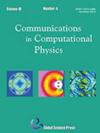使用非迭代 MFS 解决反几何问题
IF 3.1
3区 物理与天体物理
Q1 PHYSICS, MATHEMATICAL
引用次数: 0
摘要
在迄今为止用于解决反几何问题的大多数基本解法(MFS)方法中,基本解法的实施通常会导致非线性系统,而这些非线性系统是通过标准的非线性迭代最小二乘法软件求解的。在目前的方法中,我们采用了一种三步非迭代 MFS 技术,从内部数据测量中识别刚性包含,该技术由以下部分组成:(i) 计算测量点集合上的解的直接问题,(ii) 求解求解线性问题以确定已知虚拟边界上的解,(iii) 求解虚拟域内的直接问题,从而使用二维的 ${rm MATLAB}^®$ 函数轮廓和三维的等值面识别未知曲线。本文介绍并分析了稳态热传导和线性弹性二维和三维数值实验的结果。本文章由计算机程序翻译,如有差异,请以英文原文为准。
Solution of Inverse Geometric Problems Using a Non-Iterative MFS
In most of the method of fundamental solutions (MFS) approaches employed
so far for the solution of inverse geometric problems, the MFS implementation typically leads to non-linear systems which were solved by standard nonlinear iterative least squares software. In the current approach, we apply a three-step non-iterative MFS technique for identifying a rigid inclusion from internal data measurements, which consists of: (i) a direct problem to calculate the solution at the set of
measurement points, (ii) the solution of an ill-posed linear problem to determine the
solution on a known virtual boundary and (iii) the solution of a direct problem in
the virtual domain which leads to the identification of the unknown curve using the ${\rm MATLAB}^®$ functions contour in 2D and isosurface in 3D. The results of several numerical experiments for steady-state heat conduction and linear elasticity in two and
three dimensions are presented and analyzed.
求助全文
通过发布文献求助,成功后即可免费获取论文全文。
去求助
来源期刊

Communications in Computational Physics
物理-物理:数学物理
CiteScore
4.70
自引率
5.40%
发文量
84
审稿时长
9 months
期刊介绍:
Communications in Computational Physics (CiCP) publishes original research and survey papers of high scientific value in computational modeling of physical problems. Results in multi-physics and multi-scale innovative computational methods and modeling in all physical sciences will be featured.
 求助内容:
求助内容: 应助结果提醒方式:
应助结果提醒方式:


